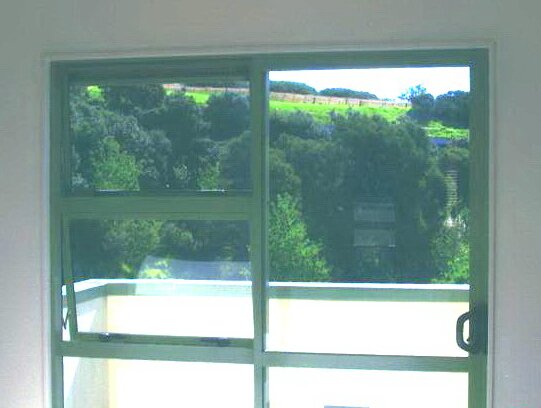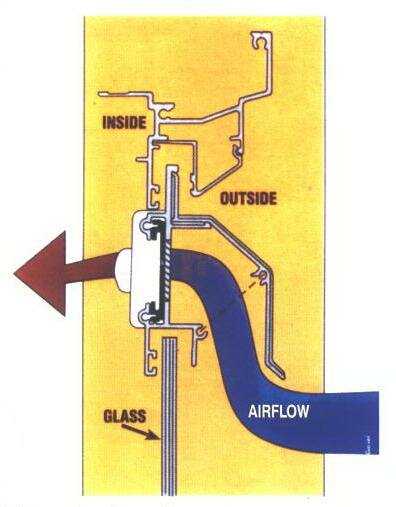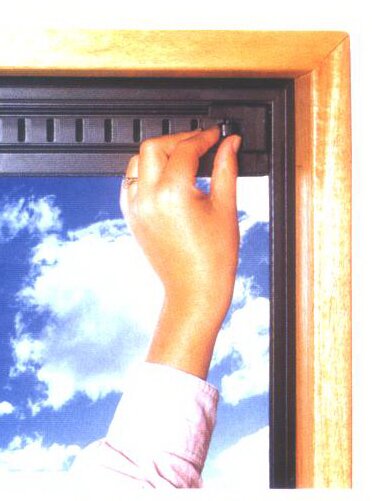Passive Background Ventilation

Ventilation is essential to healthy living. Fresh air is good for us and it is also very good for the health of our buildings. This section focuses on ventilations systems in houses that cost nothing to operate. The same principles apply to other buildings.
What is passive backgroud ventilation?
It is a system whereby adjustable ventilation is provided to every room of the house by way of the window system. It does not replace opening sashes, but is in addition to them.
The passive ventilation system is discreet as the photo shows.
Why is it needed?
Today's homes are practically airtight with draught sealed windows and doors. Pollutants, of which water vapour is the most important, created by residents and sometimes by the building process itself cannot easily escape. Excessive condensation is the usual result. The problem is made worse if the doors and windows cannot be left open for security reasons.
Passive background ventilation overcomes this problem by providing continual ventilation even when the home is locked up and the occupants away.
How does it work?

Passive ventilation relies on the principle of variations of air pressure, whereby fresh air enters the house on the windy side forcing stale and moisture laden air to exit on the sheltered side.

The illustration shows a cross section of the window frame. Air can flow in through the frame from the outside. A simple control on the inside opens and closes the vent.
How much ventilation is required?
The recommended minimum is 4000 square millimetres of free air space per average size room. This can be achieved by a minimum vent length of 600mm. The above recommendation is the same as that recommended by BRANZ.
Are there any other factors to take into consideration?
The above is for an average style home of average location. Variations in house design and location affect the amount of background ventilation required and can be predicted. The extremes at the top and bottom ends of the scale are shown below.
Multi level, sunny and exposed:
A home which falls into this category will have few, if any, condensation problems. Natural convection will assist internal air movement while the sun will warm the air and wind pressure will allow fresh air to enter the home through any openings available. A few vents distributed strategically around the home will suffice.
Single level, shady and sheltered:
A home in this category will be prone to serious condensation problems, and will require the full recommended minimum number of vents. In addition mechanical extraction of moisture at source in kitchens, bathrooms and laundries will be required.
Will ventilation alone solve condensation problems?
As air cools water vapour condenses. This condensation appears first on cold surfaces.
Avoiding condensationis therefore a combination of heat and ventilation. The internal temperature of the home needs to be at least five to seven degrees warmer than the external temperature.
Click here to go to the condensation page
What sort of heater should be used?
It is important to heat the air and thereby the internal wall coverings, the ceilings, as well as the interior furnishings. The best type of heater to heat the room air is a convection heater, perferrably fan assisted to circulate the heated air and, if appropriate to the type of heater, thermostatically controlled for energy efficiency. The heating fuel can be wood fired, electric, gas etc, but please note the following section regarding gas heaters. Radiant heaters are less effective as they tend to heat only the area immediately in front of them.
Some important notes about gas heaters
It is very important to note that gas heaters are recommended to have a chimney (flue) that is vented to the outside.
This is because un-flued gas heaters create water vapour at the rate of about 2kg of water vapour for every 1 kg of gas consumed, and it is essential to have a window open during the heating to get rid of the exhaust gases and water vapour. Opening a window to get rid of the exhust gases and water vapour reduces the fuel efficiency of the un-flued gas heater to about the same level as a gas fire with a chimney to the outside.
If the water vapour from the un-flued gas heater remains inside the building, it exacerbates the condensation problems when the room cools down. It is worthy of note that in some countries the use of un-flued gas heaters indoors is illegal because of the possible health effects of high moisture levels combined with the other exhaust gases of gas combustion. The effects of high moisture levels are mostly noticed in other rooms which are distant from the un-flued heater. This is because the moist warm air travels throughout the building and later cools down and condenses in the cooler rooms where mould growth may result. Some moulds can be very dangerous to health.
What about forced air systems?
These are around double the price, require maintenance and use power. They are no more effective under normal situations but may have an advantage in the single level sheltered and shady scenario. They are also beneficial if residents suffer from airborne allergens, because most models are supplied with air filters.
What about dehumidifiers?
These cannot control the entire house. They end to be noisy, need to have the water container emptied and consume power. They can be useful to control a condensation problem in a particularly damp area of the house.
How do I buy passive ventilation?
If you are building a new home, check with your window supplier, most of whom can supply their own, or a proprietary system built into the design of the windows.
For existing homes click onto http://joinerydev.co.nz/easy-air-ventilation/
